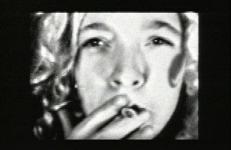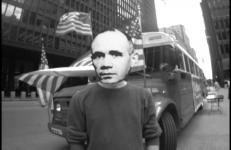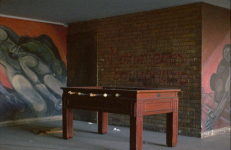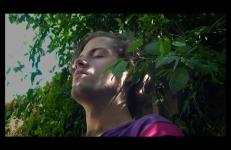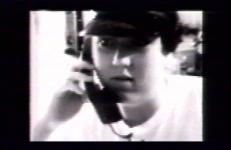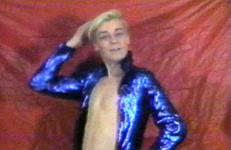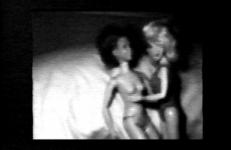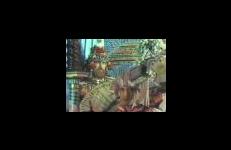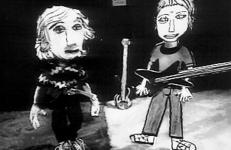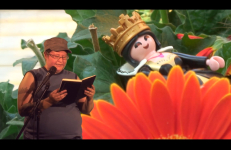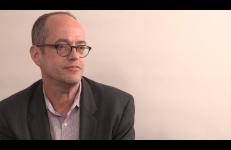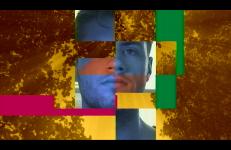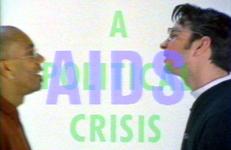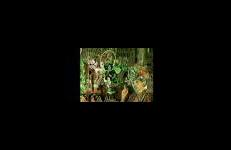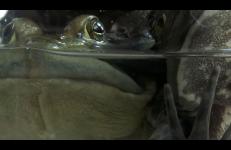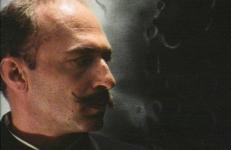This experimental video breaks many the silences surrounding lesbians and AIDS. Interweaving the voices of two friends—an HIV+ Latina lesbian and an HIV- Jewish lesbian—the video juxtaposes two very different yet overlapping experiences. The piece points to the often unspoken tensions occurring within this epidemic—survival and power, mourning and loss.
LGBTQ
This experimental video breaks many the silences surrounding lesbians and AIDS. Interweaving the voices of two friends—an HIV+ Latina lesbian and an HIV- Jewish lesbian—the video juxtaposes two very different yet overlapping experiences. The piece points to the often unspoken tensions occurring within this epidemic—survival and power, mourning and loss.
Benning illustrates a lustful encounter with a “bad girl,” through the gender posturing and genre interplay of Hollywood stereotypes: posing for the camera as the rebel, the platinum blonde, the gangster, the '50s crooner, and the heavy-lidded vamp. Cigarette poses, romantic slow dancing, and fast-action heavy metal street shots propel the viewer through the story of the love affair. Benning’s video goes farther than romantic fantasy, describing other facets of physical attraction including fear, violence, lust, guilt and total excitement.
Dykes and trans guys take over the Jackhammer for a punk show.
This title is also available on Chicago Sex Change: 2002-2008, A collection of Minax's early videos that together create a punk-documentary tapestry of young queer life in Chicago in the early 2000s.
A queer rewriting of the events surrounding the 1968 National Democratic Convention in Chicago from the point of view of French writer Jean Genet. Along the way Genet will meet, amongst others, Allen Ginsberg, William S. Burroughs, the Yippies, the Black Panther Party and the Chicago police force... Ultimately, the video is about the difficulty of aligning political and sexual desires.
Born out of an "objective hazard" (a 16mm roll where two different subjects were imprinted by mistake), jeny303 is a composite work intertwining two portraits. On the one hand there is jeny, the feminine alter ego of a transgender millennial dealing with a heroine addiction. On the other hand there is the 303 building, an iconic modernist architecture in a public university in Bogota (Colombia). The images of the body and the edifice interlace and depict jeny303, a character on the threshold of a transformation to come.
A portrait of New York author Joe Westmoreland. Joe is reading from his short story Sweet Baby Joe. This video was shot in 2014 in Joe's Chelsea loft, and the reading was recorded in 2016.
Taking queer artistic license, Dougherty and Leslie Singer together portray a gay male playwright who took 1960s London by storm. The result is a witty play on narcissism and split personality that captures the banality of stardom while paying tribute to promiscuity and transgression. Filmed in black and white pixelvision and color video, this tape continues Dougherty’s exploration of counter-culture identity through lesbian portrayal, the same ingenious bait-and-switch device seen at work in the lesbian portrayal of the Beatles in her earlier tape, Grapefruit.
A rockumentary about East Village club Pyramid star John Sex. The blonde, coifed performer exposes his penchant for padding his package with socks and explains that his last name is the result of his ancestors’ “Americanization” of his native name Sexton. Featuring Miss Maggie, Katy K, Tom Rubnitz, Kenny Scharf, and Kestutis Nakas.
This title is also available on Tom Rubnitz Videoworks: Sexy, Wiggy, Desserty.
Benning gives a chronology of her crushes and kisses, tracing the development of her nascent sexuality. Addressing the camera with an air of seduction and romance, giving the viewer a sense of her anxiety and special delight as she came to realize her lesbian identity.
This title is also available on Sadie Benning Videoworks: Volume 1.
Stephen Varble began Journey to the Sun as a series of performances with projected slides in 1978. After becoming notorious for unauthorized costume performances on Soho streets in the mid 1970s, Varble receded from his public persona at this time. Deriving from his identification with his idol, the reclusive actress Greta Garbo, and informed by the spiritual practice of Subud, Varble began writing an allegorical epic about a musician, the Grey Crowned Warbler, who undergoes tribulation and metamorphosis on a journey to transcendence.
These five short videos introduce Judy, a paper maché puppet who ruminates on her position in society. Like Judy, of the famous Punch and Judy puppet duo, Benning’s Judy seems to experience the world from the outside, letting things happen to her rather than making things happen around her.
This title is also available on Sadie Benning Videoworks: Volume 3.
Invited to speak at an Indigenous Revolutionary Meeting, the narrator describes an intimate encounter with an Evil Colonizing Queen which leads to Turtle Island's contraction of an invasive European flora.
This title is also available on the compilation What Was Always Yours and Never Lost.
Rosie Cutler, a middle school lunch lady, and TJ Fortune, a outcast student, have an unusual relationship. Mystically-minded and gender ambiguous, TJ recoils into an abandoned warehouse where he builds a massive sculptural shrine from discarded objects and trash. Through a dream Rosie makes intimate contact with a trans-worldly being who she hopes will bridge the gap between real and imagined to reveal truths about our world.
Tom Kalin is a screenwriter, film director, producer, and educator. As a key figure in New Queer Cinema, his work focuses on the portrayal of gay sexuality both in the age of AIDS and historically. Informed by his work with two AIDS activist collectives, ACT UP and Gran Fury, Kalin’s video work is characterized by appropriated images, original portraits, and performances.
He peels away layers of secrets to you for what you are, and he likes scars because they tell stories.
Kiss The Boys And Make Them Die explores how memory, sexuality, and the self are created and enforced through the family story. The video chronicles how the social act of loving women becomes channeled into narratives of incest, desire for the mother, loss of the father, separation from the family, death and self-destruction. In this work, sexuality, difference and language are paralleled with haunting memories of a childhood ghost that both desires and hates women.
Part of a campaign initiated in 1989, this video is a component of Gran Fury’s plan to raise consciousness and advance medical and federal reform on AIDS policy. These ads ran on TV as a counterpart to controversial bus posters, which generated some intensely negative reactions. Using Benneton’s "United Colors" ad campaign to a decidedly different end, simple but powerful images and modern text deliver an enlighteningly direct message.
Part of a campaign initiated in 1989, this video is a component of Gran Fury’s plan to raise consciousness and advance medical and federal reform on AIDS policy. These ads ran on TV as a counterpart to controversial bus posters, which generated some intensely negative reactions. Using Benneton’s "United Colors" ad campaign to a decidedly different end, simple but powerful images and modern text deliver an enlighteningly direct message.
La Mesa explores the intersections of memory, identity and queer desire. It recreates fragmented and romanticized stories of a childhood in rural Mexico as told by the artist’s father. These disjointed vignettes are interwoven with queered reenactments of scenes from popular culture. The artist casts himself in the old Mexican films and American Westerns he grew up watching with his family in California. He appears as the romantic lead opposite the male actors, including Pedro Infante, Mexican national hero and the filmmaker’s childhood crush.
In this video, Glennda Orgasm and Jackie Offie attend Lollapalooza '95 on Randall's Island, New York. Glennda and Jackie sing punk rock songs on the drag stage, and Glennda challenges Courtney Love to a fistfight. The video also shows other performances on the stage, and features Bruce LaBruce's music video for The Riverdales' Fun Tonight.
The performance artist Stephen Varble spent the last five years of his life working on an epic, unfinished performance-turned-video titled Journey to the Sun (1978-1983). Only partially complete and under constant revision, this complex work combined Varble’s history of making costumes for performances with his fantastic stories involving metamorphosis and martyrdom. In 1982, Varble decided to make a “prelude” to Journey to the Sun, combining existing footage with new video taken in Riverside Park in New York City.
The Baroness Elsa von Freytag-Loringhoven né Plotz, was an unsung member of the Dada Movement. A poet, artist, runaway, and all around public provocateur; she actively did not fit into her historical moment, and like most misfits, suffered for it. As with many women artists throughout history, her cultural legacy has been obscured and in some instances appropriated into the oeuvres of better known male peers.
During the winter of 1994, actor Ron Vawter was in Brussels working on a theater production about the mythical Greek warrior, Philoketes. Philoketes was abandoned by Odysseus on the island of Lemnos after he had been bitten by a snake while on route to Troy. He was betrayed by Odysseus because his wound would not heal, provoking mournful cries and a stench that distressed the other soldiers.
Laurie was inspired by Laurie Weeks’ uncanny ability to simultaneously embody her characters and write them from a clear distance. The text in question is just a few paragraphs from a draft of the novel Zipper Mouth, more than ten years in the making, and published by the Feminist Press.





